Post by glactus on Feb 17, 2008 6:00:20 GMT
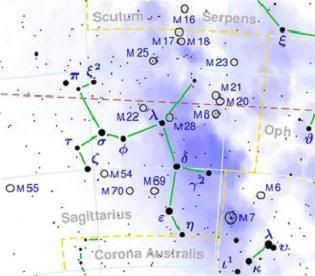
Sagittarius. Ninth sign of the zodiac. The sun passes through this constellation from late December to late January, so it is best viewed in the nights of summer time. Sagittarius is certainly worth random scanning with low power scopes as well as intense investigations of the single objects. Not only is there lots of rich star fields towards the galactic center, but also numerous clusters and nebulae. In the center of this constellation lies the conspicious asterism the Milk Dipper (it seems that it is sometimes called "The Teapot"). It lies in the beautiful star clouds of the southern Milky Way.
Notable stars:
Kaus Australis:
Kaus Australis is A double star of magnitudes 2.0 and 14.3, orange and bluish. The star has one of the few names with mixed parentage, as "Kaus" is from Arabic meaning "bow," while "Australis" from Latin clearly signifies "southern." This star may be a sort of "shell star" in which its high rotation speed (over 70 times that of the Sun) was responsible for creating a shell of gas that hides much of the star within. Distance from earth is 145 light years.
Kaus Media
Kaus Media ( delta Saggitari) is a class K (K3) giant star, but one a bit on the bright side. Its distance of 305 light years and an uncertain temperature of 4300 Kelvin lead to a luminosity 1180 times that of the Sun and a radius 62 times solar. The star is three-quarters the size of Mercury's orbit. Magnitude is 2.8.
Beta-1 Sagittarii
Beta-1 Sagittarii also called Arkab Prior since it leads its companiion beta-2 Sagittarii across the sky, is a binary star lying 378 light years from Earth. Magnitude is 5.5.
Beta-2 Sagittarii
Beta-2 Sagittarii, also called Arkab Posterior since it trails Baeta Sagittarii-1 across the sky, is a spectral type F2 giant which has an apparent magnitude of 4.27. Distance from Earth is 137 light years.
Notable objects:
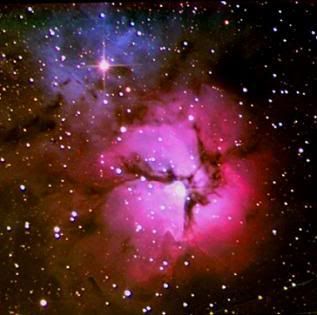
Messier M 20 the Trifid nebula
Charles Messier discovered this object on June 5, 1764, and described it as a cluster of stars of 8th to 9th magnitude, enveloped in nebulosity. The red emission nebula M 20 with its young star cluster near its center, is surrounded by a blue reflection nebula which is particularly conspicuous to the northern end. The nebula's distance is rather uncertain, with values between 2,200 light years and about 7,600 light years The Sky Catalog 2000 gives 5,200 light years, a value which we adopt here. Magnitude is 6.2.

NGC 6559
Few regions of nebulosity show the variety of color and detail that this small region around NGC 6559 does. At the top of this image wispy dark clouds hang delicately in the foreground of diffuse glowing hydrogen gas. Even though these stars have strived to push away all of the gas and dust near them; thicker portions remain and continue to scatter light which color the area with hints of blue and purple. Magnitude is 5.9 and distance from earth is 2,000 light years.
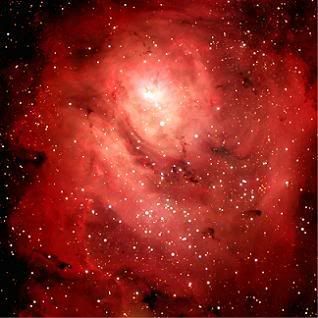
Messier M 8
M8 is situated in a very conspicuous field of the Sagittarius Milky Way. The Lagoon Nebula is a magnificient object for the amateur astrophotographer. One of the remarkable features is the presence of dark nebulae known as 'globules' which are collapsing protostellar clouds with diameters of about 10,000 (Astronomical Units), and there is also a rich star field and faint nebulae surrounding them. Magnitude is 6.0 and distance from earth is 5,200 light years.
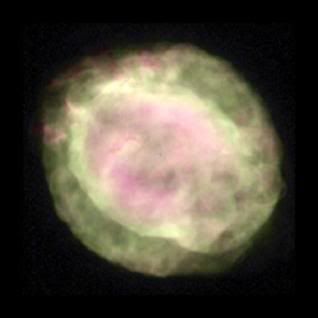
NGC 6818
NGC 6818 is just about the same size as the planet Jupiter. The images show a definite pinkish, redish
color and the nebula is bright enough to be seen in a six to eight inch scope. Astronomers believe that a fast wind from the hot central star is creating the gaseous shroud, and in fact has caused a "blowout" at the two ends of the major axis. Magnitude is 9.9 and distance is 6,000 light years.
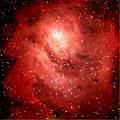
M 8 - lagoon nebula
credits:
Sagittarious map: Wikipedia
en.wikipedia.org/wiki/Sagittarius_(constellation)
image: Messier M 20: starlightccd.com
www.starlightccd.com/funstuff/hx916/pz-m20lrgb.htm
image: NGC 6559: Space.com
www.space.com/imageoftheday/image_of_day_050523.html
image: Messier M 8 lagoon
www.fli-cam.com/FLIGallery.htm
NGC 6818: Hubble Heritage image.
hubblesite.org/gallery/album/nebula_collection/pr1998011h/
Robert Rubin (NASA Ames Research Center), Reginald Dufour and Matt Browning (Rice University), Patrick Harrington (University of Maryland), and NAS.


